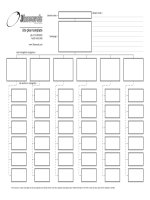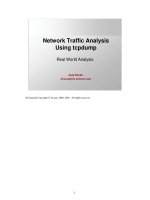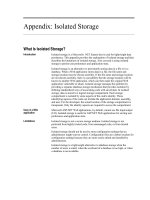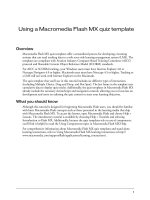Tài liệu XML development experience docx
Bạn đang xem bản rút gọn của tài liệu. Xem và tải ngay bản đầy đủ của tài liệu tại đây (918.73 KB, 16 trang )
Contents
Introduction 1
Course Materials 2
Prerequisites 3
Course Outline 4
Setup 6
Microsoft Official Curriculum 7
Microsoft Certified Professional Program 8
Facilities 11
Introduction
Information in this document, including URL and other Internet Web site references, is subject to
change without notice. Unless otherwise noted, the example companies, organizations, products,
domain names, e-mail addresses, logos, people, places, and events depicted herein are fictitious,
and no association with any real company, organization, product, domain name, e-mail address,
logo, person, place or event is intended or should be inferred. Complying with all applicable
copyright laws is the responsibility of the user. Without limiting the rights under copyright, no part
of this document may be reproduced, stored in or introduced into a retrieval system, or transmitted
in any form or by any means (electronic, mechanical, photocopying, recording, or otherwise), or
for any purpose, without the express written permission of Microsoft Corporation.
Microsoft may have patents, patent applications, trademarks, copyrights, or other intellectual
property rights covering subject matter in this document. Except as expressly provided in any
written license agreement from Microsoft, the furnishing of this document does not give you any
license to these patents, trademarks, copyrights, or other intellectual property.
©2002 Microsoft Corporation. All rights reserved.
Microsoft, MS-DOS, Windows, Windows NT, Win32, Active Directory, ActiveX, BizTalk,
IntelliSense, JScript, Microsoft Press, MSDN, PowerPoint, SQL Server, Visual Basic, Visual C#,
and Visual Studio are either registered trademarks or trademarks of Microsoft Corporation in the
United States and/or other countries.
The names of actual companies and products mentioned herein may be the trademarks of their
respective owners.
Introduction iii
Instructor Notes
The Introduction module provides students with an overview of the course
content, materials, and logistics for Course 2663, Programming with XML in
the Microsoft
® .NET Framework.
To teach this course, you need the following materials:
Delivery Guide
Trainer Materials compact disc
To prepare for this course, you must:
• Complete the Course Preparation Checklist that is included with the trainer
course materials.
Presentation:
30 minutes
Required materials
Preparation tasks
iv Introduction
How to Teach This Module
This section contains information that will help you to teach this module.
Welcome students to the course and introduce yourself. Provide a brief
overview of your background to establish credibility.
Ask students to introduce themselves and provide their background, product
experience, and expectations of the course.
Record student expectations on a whiteboard or flip chart that you can reference
later in class.
Tell students that everything they will need for this course is provided at their
desk.
Have students write their names on both sides of the name card.
Describe the contents of the student workbook and the Student Materials
compact disc.
Tell students where they can send comments and feedback on this course.
Demonstrate how to open the Web page that is provided on the Student
Materials compact disc by double-clicking Autorun.exe or Default.htm in the
StudentCD folder on the Trainer Materials compact disc.
Describe the prerequisites for this course. This is an opportunity for you to
identify students who may not have the appropriate background or experience
to attend this course.
Briefly describe each module and what students will learn. Be careful not to go
into too much detail because the course is introduced in detail in Module 1.
Explain how this course will meet students’ expectations by relating the
information that is covered in individual modules to their expectations.
Describe any necessary setup information for the course, including course files
and classroom configuration.
Explain the Microsoft Official Curriculum (MOC) program and present the list
of additional recommended courses.
Refer students to the Microsoft Official Curriculum Web page at
for information about curriculum
paths.
Inform students about the Microsoft Certified Professional (MCP) program, any
certification exams that are related to this course, and the various certification
options.
Explain the class hours, extended building hours for labs, parking, restroom
location, meals, phones, message posting, and where smoking is or is not
allowed.
Let students know if your facility has Internet access that is available for them
to use during class breaks.
Also make sure that the students are aware of the recycling program if one is
available.
Introduction
Course materials
Prerequisites
Course outline
Setup
Microsoft Official
Curriculum
Microsoft Certified
Professional program
Facilities
Introduction 1
Introduction
Name
Company affiliation
Title / function
Job responsibility
Programming language preference
XML development experience
Expectations for the course
*****************************
ILLEGAL FOR NON-TRAINER USE******************************
2 Introduction
Course Materials
Name card
Student workbook
Student Materials compact disc
Course evaluation
*****************************
ILLEGAL FOR NON-TRAINER USE******************************
The following materials are included with your kit:
Name card. Write your name on both sides of the name card.
Student workbook. The student workbook contains the material covered in
class, in addition to the hands-on lab exercises.
Student Materials compact disc. The Student Materials compact disc
contains the Web page that provides you with links to resources pertaining
to this course, including additional readings, review and lab answers, lab
files, multimedia presentations, and course-related Web sites.
To open the Web page, insert the Student Materials compact disc into
the CD-ROM drive, and then in the root directory of the compact disc,
double-click Autorun.exe or Default.htm.
Course evaluation. To provide feedback on the course, training facility, and
instructor, you will have the opportunity to complete an online evaluation
near the end of the course.
To provide additional comments or inquire about the Microsoft Certified
Professional program, send e-mail to
.
Note
Introduction 3
Prerequisites
Completion of Course 2500, Introduction to XML and
the Microsoft .NET Platform, or equivalent experience
with XML documents
Familiarity with XSLT, XPath, XML schemas
Programming experience with a .NET language
Visual Basic or C# or C++
Familiarity with the Microsoft Visual Studio .NET
developer environment
*****************************
ILLEGAL FOR NON-TRAINER USE******************************
This course requires that you meet the following prerequisites:
Completion of Course 2500, Introduction to XML and the Microsoft .NET
Platform, or equivalent experience with XML
Experience with programming languages such as Microsoft Visual Basic®
.NET or C#
Experience using the Microsoft Visual Studio® .NET developer
environment
Experience developing applications using XSLT, XPath, and XML Schemas
4 Introduction
Course Outline
Module 1: Introduction to XML in the .NET Framework
Module 2: Parsing XML
Module 3: Validating XML
Module 4: Writing XML
Module 5: Querying XML
Module 6: Manipulating Cached XML
Module 7: Transforming XML
Module 8: Serializing Objects as XML
*****************************
ILLEGAL FOR NON-TRAINER USE******************************
Module 1, “Introduction to XML in the .NET Framework,” introduces the use
of XML in the .NET Framework to help solve common business problems.
After completing this module, you will be able to describe the business
problems that XML and the Microsoft .NET framework address.
Module 2, “Parsing XML,” discusses how to parse Extensible Markup
Language (XML) data from a file, string, or stream by using the XmlReader
class. It also covers how to use the XmlTextReader to process XML as text,
and the XmlNodeReader to filter data by using an XML Path Language
(XPath) expression and the object. After completing this module, you will be
able to write code that reads and processes XML data by using one of the three
XML readers.
Module 3, “Validating XML,” discusses storage issues and explains how to
create a device, a database, and a table. After completing this module, you will
be able to write code that associates an XML schema with a validating reader
and validates the structure of an XML document or fragment.
Module 4, “Writing XML,” introduces the .NET Framework classes that you
use to write XML with or without namespaces. The module also explains how
to control the format and validity of XML as it is being written. After
completing this module, you will be able to write code that generates
well-formed XML from a data file.
Introduction 5
Module 5, “Querying XML,” explains the process of querying an XML
document by using XPath. After completing this module, you will be able to
find a specific location in an XML document, examine its contents, and return a
node set.
Module 6, “Manipulating Cached XML,” introduces the XML Document
Object Model (XML DOM) and explains how to locate and manipulate XML
by using the DOM. After completing this module, you will be able to write
code that opens and closes an XML document by using the DOM, and to
navigate the document and add, delete, and modify nodes.
Module 7, “Transforming XML, ” explains the process of transforming XML
documents. This module teaches you how to apply an Extensible Stylesheet
Language for Transformation (XSLT) transformation to an XML document by
using the .NET XML classes. It does not teach XSLT syntax or commands.
After completing this module, you will be able to create and apply style sheets
that display XML data on a Web page.
Module 8, “Serializing Objects as XML,” describes XML serialization, why it
is useful, and how serialization is performed by using the XmlSerializer class.
After completing this module, you will be able to serialize and deserialize
objects by using the XmlSerializer class.
6 Introduction
Setup
Microsoft Windows XP Professional
Microsoft Visual Studio .NET Enterprise
Developer Edition
Microsoft .NET Framework 1.0 Service Pack 1
*****************************
ILLEGAL FOR NON-TRAINER USE******************************
The following table shows all of the software needed to set up the classroom for
this course, including the version that was tested with the course and where the
software can be found.
Software Version tested and notes
Microsoft Windows® XP Professional RTM version
Microsoft Visual Studio .NET
Enterprise Developer Edition
RTM Version, including Windows
Component Update
Microsoft PowerPoint
® 2002
(instructor computer only)
Microsoft Office XP Developer Edition
compact disc
Microsoft .NET Framework 1.0
Service Pack 1
/>downloads/sp1/download.asp
There are files associated with the labs in this course. The lab files are located
in the folder install_folder\Labfiles\LabXX on the student computers.
Software
Course files
Introduction 7
Microsoft Official Curriculum
/>2663, Programming with
XML in the Microsoft .NET
Framework
1905, Building XML-Based
Web Applications
2500, Introduction to XML
and the Microsoft .NET
Platform
*****************************
ILLEGAL FOR NON-TRAINER USE******************************
Microsoft Training and Certification develops Microsoft Official Curriculum
(MOC), including MSDN
® Training, for computer professionals who design,
develop, support, implement, or manage solutions by using Microsoft products
and technologies. These courses provide comprehensive skills-based training in
instructor-led and online formats.
Each course relates in some way to another course. A related course may be a
prerequisite, a follow-up course in a recommended series, or a course that offers
additional training.
Course Title and description
1913 Exchanging and Transforming Data Using XML and XSLT
2091 Building XML-Enabled Applications Using Microsoft SQL Server
™
2000
2389 Programming with ADO.NET
Other related courses may become available in the future. For up-to-date
information about recommended courses, visit the Microsoft Training and
Certification Web site at
Introduction
Additional
recommended courses
Microsoft Training and
Certification information
8 Introduction
Microsoft Certified Professional Program
/>
*****************************
ILLEGAL FOR NON-TRAINER USE******************************
Microsoft Training and Certification offers a variety of certification credentials
for developers and information technology professionals. The Microsoft
Certified Professional program is the leading certification program for
validating your experience and skills, keeping you competitive in today’s
changing business environment.
The Microsoft Certified Professional program includes the following
certifications:
MCSA on Microsoft Windows 2000
The Microsoft Certified Systems Administrator (MCSA) certification is
designed for professionals who implement, manage, and troubleshoot
existing network and system environments based on Microsoft
Windows 2000 platforms, including the Windows .NET Server family.
Implementation responsibilities include installing and configuring parts of
the systems. Management responsibilities include administering and
supporting the systems.
MCSE on Microsoft Windows 2000
The Microsoft Certified Systems Engineer (MCSE) credential is the premier
certification for professionals who analyze the business requirements and
design and implement the infrastructure for business solutions based on the
Microsoft Windows 2000 platform and Microsoft server software, including
the Windows .NET Server family. Implementation responsibilities include
installing, configuring, and troubleshooting network systems.
Introduction
MCP certifications
Introduction 9
MCSD
The Microsoft Certified Solution Developer (MCSD) credential is the
premier certification for professionals who design and develop leading-edge
business solutions with Microsoft development tools, technologies,
platforms, and the Microsoft Windows DNA architecture. The types of
applications that MCSDs can develop include desktop applications and
multi-user, Web-based, N-tier, and transaction-based applications. The
credential covers job tasks ranging from analyzing business requirements to
maintaining solutions.
MCDBA on Microsoft SQL Server 2000
The Microsoft Certified Database Administrator (MCDBA) credential is the
premier certification for professionals who implement and administer
Microsoft SQL Server databases. The certification is appropriate for
individuals who derive physical database designs, develop logical data
models, create physical databases, create data services by using
Transact-SQL, manage and maintain databases, configure and manage
security, monitor and optimize databases, and install and configure
SQL Server.
MCP
The Microsoft Certified Professional (MCP) credential is for individuals
who have the skills to successfully implement a Microsoft product or
technology as part of a business solution in an organization. Hands-on
experience with the product is necessary to successfully achieve
certification.
MCT
Microsoft Certified Trainers (MCTs) demonstrate the instructional and
technical skills that qualify them to deliver Microsoft Official Curriculum
through Microsoft Certified Technical Education Centers (Microsoft
CTECs).
The certification requirements differ for each certification category and are
specific to the products and job functions addressed by the certification. To
become a Microsoft Certified Professional, you must pass rigorous certification
examinations that provide a valid and reliable measure of technical proficiency
and expertise.
See the Microsoft Training and Certification Web site at
You can also send e-mail to if you have specific
certification questions.
Certification
requirements
For More Information
10 Introduction
MOC and MSDN Training Curriculum can help you to develop the skills that
you need to do your job. They also complement the experience that you gain
while working with Microsoft products and technologies. However, no one-to-
one correlation exists between MOC and MSDN Training courses and MCP
exams. Microsoft does not expect or intend for the courses to be the sole
preparation method for passing MCP exams. Practical product knowledge and
experience is also necessary to pass the MCP exams.
To help prepare for the MCP exams, use the preparation guides that are
available for each exam. Each Exam Preparation Guide contains exam-specific
information, such as a list of the topics on which you will be tested. These
guides are available on the Microsoft Training and Certification Web site at
Acquiring the skills
tested by an MCP exam
Introduction 11
Facilities
Class hours
Building hours
Parking
Restrooms
Meals
Phones
Messages
Smoking
Recycling
*****************************
ILLEGAL FOR NON-TRAINER USE******************************
THIS PAGE INTENTIONALLY LEFT BLANK









